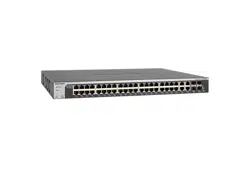Loading ...
Loading ...
Loading ...

Configuration Examples
356
ProSAFE 10-Gigabit Smart Managed Switch XS728T and XS748T User Manual
• CoS. 0
• Destination MAC. 01:02:1A:BC:DE:EF
• Destination MAC Mask. 00:00:00:00:FF:FF
• Source MAC. 02:02:1A:BC:DE:EF
• Source MAC Mask. 00:00:00:00:FF:FF
• VLAN ID. 2
For more information about MAC ACL rules, see Configure MAC ACL Rules on
page 280.
3. On the MAC Binding Configuration page, assign the Sales_ACL to ports 6, 7, and 8, and
then click the Apply button. (See Configure MAC Bindings on page 284.)
You can assign an optional sequence number to indicate the order of this access list
relative to other access lists if any are already assigned to this interface and direction.
4. The MAC Binding Table displays the interface and MAC ACL binding information. (See View
or Delete MAC ACL Bindings in the MAC Binding Table on page 286.)
The ACL named Sales_ACL looks for Ethernet frames with destination and source MAC
addresses and MAC masks defined in the rule. Also, the frame must be tagged with VLAN ID
2, which is the Sales department VLAN. The CoS value of the frame must be 0, which is the
default value for Ethernet frames. Frames that match this criteria are permitted on interfaces
6, 7, and 8 and are assigned to the hardware egress queue 0, which is the default queue. All
other traffic is explicitly denied on these interfaces. To allow additional traffic to enter these
ports, you must add a new Permit rule with the desired match criteria and bind the rule to
interfaces 6, 7, and 8.
Sample Standard IP ACL Configuration
The following example shows how to create an IP-based ACL that prevents any IP traffic
from the Finance department from being allowed on the ports that are associated with other
departments. Traffic from the Finance department is identified by each packet’s network IP
address.
1. On the IP ACL page, create a new IP ACL with an IP ACL ID of 1. (See Configure an IP
ACL on page 287.)
2. On the IP Rules page, create a rule for IP ACL 1 with the following settings:
• Rule ID. 1
• Action. Deny
• Match Every. False
• Source IP Address. 192.168.187.0
• Source IP Mask. 255.255.0
For additional information about IP ACL rules, see Configure Rules for a Basic IP ACL on
page 289.
3. Click the Add button.
Loading ...
Loading ...
Loading ...
